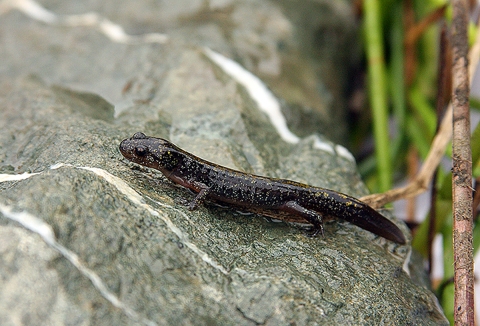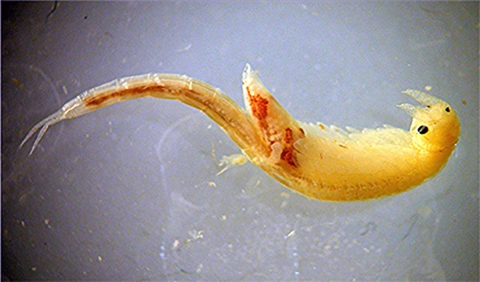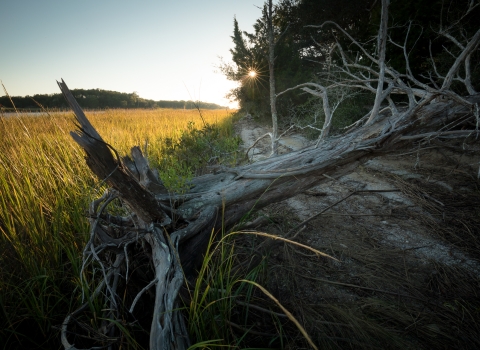With over 300 threatened and endangered species, California has more federally protected animals than any other state, and ranks second to Hawaii in the number of protected plants. A large number of these species are located along densely populated coastal areas, where they are threatened with habitat loss from urbanization.
Although the California condor (Gymnogyps californianus), desert tortoise (Gopherus agassizii), and Southern sea otter (Enhydra lutris nereis) are well-known species of the Golden State, most listed species in California are less recognizable. But that does not mean they are not important. The Santa Cruz long-toed salamander (Ambystoma macrodactylum croceum), Pacific pocket mouse (Perognathus longimembris pacificus), and vernal pool fairy shrimp (Branchinecta lynchi) are three small species that are rarely seen. While tiny, each plays a major role in maintaining the ecosystem health in California. Since gaining Endangered Species Act protection, the U.S. Fish and Wildlife Service has worked with many valued partners to conserve these species and their habitat.
Santa Cruz Long-toed Salamander
Located along the central coast of California in southern Santa Cruz and northern Monterey counties, the Santa Cruz long-toed salamander is glossy black with metallic orange or yellow markings on its backside. While distinctive in appearance, it is very secretive, and spends most of its adult life underground in small mammal burrows, under leaf litter and among the root systems of trees. During breeding season, the salamander returns to the shallow, primarily seasonal, freshwater ponds adjacent to its upland habitat area.
When the salamander was initially discovered, only two breeding populations were known to exist: Valencia Lagoon and Ellicott Pond. The salamander was one of the first species to gain federal protection under the Endangered Species Preservation Act on 1967, a precursor to the Endangered Species Act. In 1973, the California Department of Fish and Game purchased Ellicott Pond and designated it as an Ecological Reserve. In 1975, the Service established Ellicott Slough National Wildlife Refuge on surrounding lands, providing additional habitat for the salamander. Today, 25 known breeding sites exist, one of which was discovered as recently as 2013—the first discovery in 10 years.
The Pacific Pocket Mouse
One of the smallest rodents in North America, the Pacific pocket mouse measures just four inches in length and weighs slightly more than a quarter. Once common along the coast from Los Angeles County south to the border of Mexico, this diminutive mouse was no match for agricultural and urban development. Thought to be extinct in the wild by 1971, the species was rediscovered 20 years later at the Dana Point Headlands and listed as endangered in 1994. A year after listing, three additional small populations were found within Marine Corps Base, Camp Pendleton.
Efforts to recover the pocket mouse have largely focused on research to improve our understanding of its biology and habitat affinities. For the past several years, San Diego Zoo Global has partnered with the Service to assist in developing a captive breeding program.
Vernal Pool Fairy Shrimp
Another often overlooked species is the vernal pool fairy shrimp, a tiny crustacean that measures an inch long, with a delicate elongate body, large stalked compound eyes, and eleven pairs of swimming legs.
Listed as threatened in 1994, the vernal pool fairy shrimp lives in vernal pools, or seasonal ponds that fill with water during the rainy season. The fairy shrimp feeds on algae, bacteria and other microorganisms, and provide a high protein food source for some migrating waterfowl species.
The vernal pool fairy shrimp is one of several species addressed by the Recovery Plan for Vernal Pool Ecosystems of California. Implementation of this recovery plan is a story of successful partnerships and the efforts behind vernal pool conservation are gaining momentum. Last year, multiple state and federal agencies, conservation groups, and local organizations met for the third annual Vernal Pool Forum in Sacramento to discuss and collaborate on a variety of topics ranging from vernal pool mapping to the construction, management, and monitoring of compensatory mitigation and restoration sites.
These three species are just a few of the many small but important creatures that help the Golden State remain healthy for people and wildlife.





